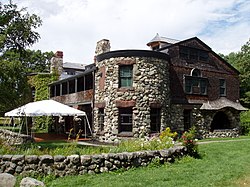| Revision as of 14:18, 29 September 2008 editJLaTondre (talk | contribs)Administrators45,017 editsm sub-categorizing historic house museums by state using AWB← Previous edit | Revision as of 00:26, 6 October 2008 edit undo24.62.62.192 (talk)No edit summaryNext edit → | ||
| Line 21: | Line 21: | ||
| == History == | == History == | ||
| Today's house began in 1866 when Boston |
Today's house began in 1866 when Boston lawyer turned philanthropist ] (1835-1910) and his wife Lydia Lyman Paine commissioned architect ] to build a ]ed ] summer house in Waltham. The house and its site were paid for by George Lyman, Lydia’s father and owner of an adjacent summer residence, the ]. This original house, however, proved too small for the Paines and their seven children, two of whom died before the Richardson addition was ever contemplated. | ||
| Thus in October 1883, Richardson and Olmsted made their first visit to the property to discuss relocating the extant 1866 Second Empire house, and designing both the surrounding grounds and a large Richardsonian addition to the house. Discussion continued until July 1884, when Olmsted and Richardson produced sketches, and agreed on a new house site high atop a rocky ridge with sweeping views to the southeast. In the spring of 1885, construction began on the new addition while the Paine family traveled to Europe with ], a family friend and pastor of Trinity Church in Boston. When Richardson died prematurely at age 47 in April 1886, the commission was close to completion. The terrace and some interior finishes were completed over the summer. | Thus in October 1883, Richardson and Olmsted made their first visit to the property to discuss relocating the extant 1866 Second Empire house, and designing both the surrounding grounds and a large Richardsonian addition to the house. Discussion continued until July 1884, when Olmsted and Richardson produced sketches, and agreed on a new house site high atop a rocky ridge with sweeping views to the southeast. In the spring of 1885, construction began on the new addition while the Paine family traveled to Europe with ], a family friend and pastor of Trinity Church in Boston. When Richardson died prematurely at age 47 in April 1886, the commission was close to completion. The terrace and some interior finishes were completed over the summer. | ||
Revision as of 00:26, 6 October 2008
United States historic place| Paine, Robert Treat, Jr., House | |
| U.S. National Register of Historic Places | |
| U.S. National Historic Landmark | |
 Exterior view Exterior view | |
 | |
| Location | Waltham, Massachusetts |
|---|---|
| Coordinates | 42°23′16.61″N 71°13′53.21″W / 42.3879472°N 71.2314472°W / 42.3879472; -71.2314472 |
| Built | 1866 |
| Architect | Henry Hobson Richardson; Fredrick Law Olmsted |
| Architectural style | Shingle Style |
| NRHP reference No. | 75000291 |
| Added to NRHP | October 07, 1975 |


The Robert Treat Paine Estate (109 acres) known as Stonehurst, is a country house designed in collaboration between architect Henry Hobson Richardson and landscape architect Frederick Law Olmsted. It is located at 100 Robert Treat Paine Drive, Waltham, Massachusetts. Since 1974 the estate has been owned by the City of Waltham, and is believed to be the only residential collaboration by Richardson and Olmsted that is open to the public.
History
Today's house began in 1866 when Boston lawyer turned philanthropist Robert Treat Paine, Jr. (1835-1910) and his wife Lydia Lyman Paine commissioned architect Gridley James Fox Bryant to build a mansarded Second Empire summer house in Waltham. The house and its site were paid for by George Lyman, Lydia’s father and owner of an adjacent summer residence, the Lyman Estate. This original house, however, proved too small for the Paines and their seven children, two of whom died before the Richardson addition was ever contemplated.
Thus in October 1883, Richardson and Olmsted made their first visit to the property to discuss relocating the extant 1866 Second Empire house, and designing both the surrounding grounds and a large Richardsonian addition to the house. Discussion continued until July 1884, when Olmsted and Richardson produced sketches, and agreed on a new house site high atop a rocky ridge with sweeping views to the southeast. In the spring of 1885, construction began on the new addition while the Paine family traveled to Europe with Phillips Brooks, a family friend and pastor of Trinity Church in Boston. When Richardson died prematurely at age 47 in April 1886, the commission was close to completion. The terrace and some interior finishes were completed over the summer.
Episode #2104 of This Old House featured a tour of the estate.
Notes
- "National Register Information System". National Register of Historic Places. National Park Service. 2007-01-23.
References
- Margaret Henderson Floyd, "H. H. Richardson, Frederick Law Olmsted, and the House for Robert Treat Paine", Winterthur Portfolio, Vol. 18, No. 4 (Winter, 1983), pp. 227-248.
- Ann Clifford and Thomas M. Paine. Stonehurst, The Robert Treat Paine Estate: An American Masterwork by H.H. Richardson and F.L. Olmsted. Waltham, Massachusetts: Robert Treat Paine Historical Trust, 2007.
External links
| U.S. National Register of Historic Places | |
|---|---|
| Topics | |
| Lists by state |
|
| Lists by insular areas | |
| Lists by associated state | |
| Other areas | |
| Related | |